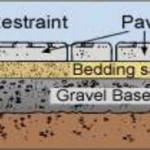Bedding in Construction: A Crucial Element for Stability and Durability
In the world of construction, where precision and stability are paramount, the term “bedding” refers to the layer of material placed beneath a structure or component to ensure its proper support, alignment, and even distribution of load. This seemingly simple layer plays a crucial role in the overall integrity and longevity of a structure. Bedding materials come in various forms, each designed to address specific requirements and challenges presented by the construction project.
Types of Bedding Materials
The choice of bedding material is dictated by the nature of the structure, the load it will bear, and the environmental conditions it will face. Common bedding materials include:
- Sand: A readily available and economical option, sand is suitable for lighter loads and provides good drainage. It is often used for shallow foundations and paving.
- Gravel: Offering better load-bearing capacity than sand, gravel is a popular choice for heavier structures and provides excellent drainage. It is commonly used for foundations, retaining walls, and road construction.
- Concrete: A highly durable and strong material, concrete is used for bedding when a high degree of stability and load-bearing capacity is required. It is frequently employed for foundations, sidewalks, and driveways.
- Mortar: A mixture of cement, sand, and water, mortar provides a smooth, even bedding surface and is suitable for laying bricks, blocks, and other masonry units.
Key Functions of Bedding
Bedding serves several crucial functions in construction, ensuring the overall stability and durability of structures:
Support and Load Distribution
Bedding provides a stable foundation for structures, distributing the load evenly across the underlying soil or foundation. This prevents uneven settling and potential structural damage. The choice of bedding material directly influences its load-bearing capacity, with materials like concrete being suitable for heavier structures and sand for lighter loads.
Alignment and Leveling
Bedding plays a vital role in achieving accurate alignment and leveling of structures. A well-prepared bed ensures that components are positioned correctly, reducing stress points and enhancing the structural integrity of the project. This is particularly important for structures like walls, floors, and pavements.
Drainage and Moisture Control
Bedding materials, particularly those with good drainage properties like sand and gravel, help to prevent water accumulation beneath structures. This minimizes the risk of moisture damage, foundation instability, and the growth of harmful microorganisms. Proper drainage is crucial for ensuring the long-term durability of the structure.
Factors Affecting Bedding Choice
The selection of bedding material is influenced by a combination of factors, including:
- Type of Structure: The size, weight, and intended use of the structure will influence the required load-bearing capacity of the bedding material.
- Soil Conditions: The type and quality of soil underlying the construction site determine the suitability of different bedding materials. For example, sandy soil might require a different bedding approach than clay soil.
- Environmental Factors: Exposure to moisture, freeze-thaw cycles, and other environmental conditions impact the longevity and performance of bedding materials. Choosing materials resistant to these factors is essential.
- Budgetary Constraints: The cost of different bedding materials varies, and the project budget will play a role in the final decision. Economical options like sand and gravel might be suitable for certain applications, while others require more durable and expensive materials like concrete.
Importance of Proper Bedding Preparation
The success of bedding in fulfilling its crucial functions relies heavily on its proper preparation. This includes:
- Site Preparation: The construction site must be properly leveled and compacted to ensure a stable foundation for the bedding material. Any loose debris or unsuitable soil should be removed.
- Bed Depth: The depth of the bedding layer will depend on the load it will bear and the chosen material. It's crucial to follow the recommended depth for the specific application.
- Moisture Control: The moisture content of the bedding material must be carefully controlled to ensure optimal compaction and stability.
- Compaction: After spreading the bedding material, it must be carefully compacted to achieve the desired density and load-bearing capacity. This can be done using specialized equipment like rollers or tampers.
Ignoring proper bedding preparation can lead to a range of problems, including uneven settling, structural damage, and premature failure of the structure. By adhering to best practices for bedding preparation, construction professionals can ensure the stability, longevity, and overall success of their projects.

How Does Proper Bedding Allow A Pipe To Sleep Well Mcwane Ductile Iron Strong

Laying Setts Pavingexpert

How Does Proper Bedding Allow A Pipe To Sleep Well Mcwane Ductile Iron Strong
Functions Of Bedding And Filling Materials

Construction Of Permeable Pavement Layer 1 Picp Not Yet Constructed Scientific Diagram

Construction Of The Prisms A Detail Full Bedding Type B Scientific Diagram

Bedding Designing Buildings

How Does Proper Bedding Allow A Pipe To Sleep Well Mcwane Ductile Iron Strong

Cross Section Of Orientation Bedding Planes In Typical Ashlar Scientific Diagram

Select Bedding Civil Engineering Dictionary
Related Posts








